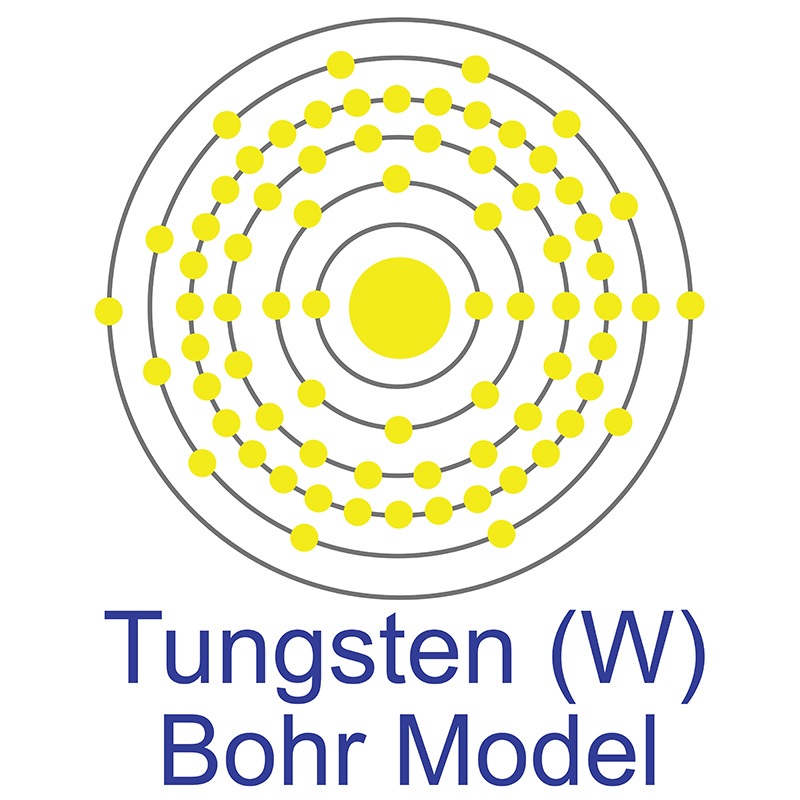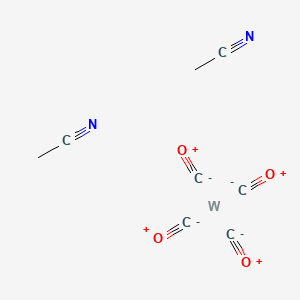SECTION 1. IDENTIFICATION
Product Name: Bis(acetonitrile)tetracarbonyltungsten(0)
Product Number: All applicable American Elements product codes, e.g. W-OMX-01-16800
CAS #: 16800-45-6
Relevant identified uses of the substance: Scientific research and development
Supplier details:
American Elements
10884 Weyburn Ave.
Los Angeles, CA 90024
Tel: +1 310-208-0551
Fax: +1 310-208-0351
Emergency telephone number:
Domestic, North America: +1 800-424-9300
International: +1 703-527-3887
SECTION 2. HAZARDS IDENTIFICATION
2.1 Classification of the substance or mixture
Classification according to Regulation (EC) No 1272/2008
The substance is not classified according to the CLP regulation.
2.2 Label elements
Labelling according to Regulation (EC) No 1272/2008 Void
Hazard pictograms Void
Signal word Void
Hazard statements Void
Precautionary statements
P231 Handle under inert gas.
P262 Do not get in eyes, on skin, or on clothing.
P280 Wear protective gloves/protective clothing/eye protection/face protection.
P305+P351+P338 IF IN EYES: Rinse cautiously with water for several minutes. Remove contact lenses, if
present and easy to do. Continue rinsing.
P422 Store contents under inert gas.
P501 Dispose of contents/container in accordance with local/regional/national/international
regulations.
2.3 Other hazards
Results of PBT and vPvB assessment
PBT: N/A
vPvB: N/A
SECTION 3. COMPOSITION/INFORMATION ON INGREDIENTS
3.1 Chemical characterisation: Substances
CAS # / Substance Name
16800-45-6 Bis(acetonitrile)tetracarbonyltungsten(0)
SECTION 4. FIRST AID MEASURES
4.1 Description of first aid measures
General information: No special measures required.
If inhaled: Supply fresh air; consult doctor in case of complaints.
In case of skin contact: Generally the product does not irritate the skin.
In case of eye contact: Rinse opened eye for several minutes under running water. Consult a physician.
If swallowed: If symptoms persist consult doctor.
4.2 Most important symptoms and effects, both acute and delayed:
No data available
4.3 Indication of any immediate medical attention and special treatment needed
No data available
SECTION 5. FIREFIGHTING MEASURES
5.1 Extinguishing media
Suitable extinguishing agents:
CO2, powder or water spray. Fight larger fires with water spray or alcohol resistant foam.
5.2 Special hazards arising from the substance or mixture No data available
5.3 Advice for firefighters
Protective equipment: No special measures required.
SECTION 6. ACCIDENTAL RELEASE MEASURES
6.1 Personal precautions, protective equipment and emergency procedures Not required.
6.2 Environmental precautions: Do not allow to enter sewers/ surface or groundwater.
6.3 Methods and materials for containment and cleanup:
Dispose contaminated material as waste according to item 13.
6.4 Reference to other sections
See Section 7 for information on safe handling.
See Section 8 for information on personal protection equipment.
See Section 13 for disposal information.
SECTION 7. HANDLING AND STORAGE
7.1 Precautions for safe handling
No special measures required.
Open and handle receptacle with care.
Handling: Handle under inert gas.
Information about fire - and explosion protection: No special measures required.
7.2 Conditions for safe storage, including any incompatibilities: Store contents under inert gas.
Requirements to be met by storerooms and receptacles: No special requirements.
Information about storage in one common storage facility: Not required.
Further information about storage conditions: None.
7.3 Specific end use(s) No data available
SECTION 8. EXPOSURE CONTROLS/PERSONAL PROTECTION
Additional information about design of technical facilities: No further data; see item 7.
8.1 Control parameters
Ingredients with limit values that require monitoring at the workplace: Not required.
Additional information: The lists valid during the making were used as basis.
8.2 Exposure controls
Personal protective equipment:
General protective and hygienic measures:
The usual precautionary measures are to be adhered to when handling chemicals.
Respiratory protection: Not required.
Protection of hands:
SProtective gloves
The glove material has to be impermeable and resistant to the product/ the substance/ the preparation.
Due to missing tests no recommendation to the glove material can be given for the product/ the preparation/ the
chemical mixture.
Selection of the glove material on consideration of the penetration times, rates of diffusion and the degradation
Material of gloves
The selection of the suitable gloves does not only depend on the material, but also on further marks of quality and
varies from manufacturer to manufacturer.
Penetration time of glove material
The exact break through time has to be found out by the manufacturer of the protective gloves and has to be
observed.
Eye protection: Safety glasses
SECTION 9. PHYSICAL AND CHEMICAL PROPERTIES
9.1 Information on basic physical and chemical properties
Appearance:
Form: Solid
Colour: Yellow
Odor: Characteristic
Odor threshold: No data available.
pH: N/A
Melting point/Melting range: Undetermined.
Boiling point/Boiling range: Undetermined.
Flash point: N/A
Flammability (solid, gas): Product is not flammable.
Ignition temperature:
Decomposition temperature: No data available.
Self-igniting: No data available.
Danger of explosion: Product does not present an explosion hazard.
Explosion limits:
Lower: No data available.
Upper: No data available.
Vapor pressure: N/A
Density: No data available.
Relative density No data available.
Vapor density N/A
Evaporation rate N/A
Solubility in / Miscibility with
water: Insoluble.
Partition coefficient (n-octanol/water): No data available.
Viscosity:
Dynamic: N/A
Kinematic: N/A
Solvent content:
Organic solvents: 0.0 %
VOC (EC) 0.00 %
Solids content: 100.0 %
9.2 Other information No data available
SECTION 10. STABILITY AND REACTIVITY
10.1 Reactivity No data available
10.2 Chemical stability
Thermal decomposition / conditions to be avoided: No decomposition if used according to specifications.
10.3 Possibility of hazardous reactions No dangerous reactions known.
10.4 Conditions to avoid No data available
10.5 Incompatible materials: No data available
10.6 Hazardous decomposition products: No dangerous decomposition products known.
SECTION 11. TOXICOLOGICAL INFORMATION
11.1 Information on toxicological effects
Acute toxicity Based on available data, the classification criteria are not met.
Primary irritant effect:
Skin corrosion/irritation Based on available data, the classification criteria are not met.
Serious eye damage/irritation Based on available data, the classification criteria are not met.
Respiratory or skin sensitisation Based on available data, the classification criteria are not met.
CMR effects (carcinogenity, mutagenicity and toxicity for reproduction)
Germ cell mutagenicity Based on available data, the classification criteria are not met.
Carcinogenicity Based on available data, the classification criteria are not met.
Reproductive toxicity Based on available data, the classification criteria are not met.
STOT-single exposure Based on available data, the classification criteria are not met.
STOT-repeated exposure Based on available data, the classification criteria are not met.
Aspiration hazard Based on available data, the classification criteria are not met.
SECTION 12. ECOLOGICAL INFORMATION
12.1 Toxicity
Aquatic toxicity: No data available
12.2 Persistence and degradability No data available
12.3 Bioaccumulative potential No data available
12.4 Mobility in soil No data available
Additional ecological information:
Water hazard class 1 (German Regulation) (Self-assessment): slightly hazardous for water
Do not allow undiluted product or large quantities of it to reach groundwater, water courses, or sewage systems.
12.5 Results of PBT and vPvB assessment
PBT: N/A
vPvB: N/A
12.6 Other adverse effects No data available
SECTION 13. DISPOSAL CONSIDERATIONS
13.1 Waste treatment methods
Recommendation Disposal must be made according to official regulations.
Uncleaned packaging:
Recommendation: Disposal must be made according to official regulations.
SECTION 14. TRANSPORT INFORMATION
14.1 UN-Number
ADR, ADN, IMDG, IATA not regulated
14.2 UN proper shipping name
ADR, ADN, IMDG, IATA not regulated
14.3 Transport hazard class(es)
ADR, ADN, IMDG, IATA
Class not regulated
14.4 Packing group
ADR, IMDG, IATA not regulated
14.5 Environmental hazards: N/A
14.6 Special precautions for user N/A
14.7 Transport in bulk according to Annex II of
Marpol and the IBC Code N/A
UN "Model Regulation": not regulated
SECTION 15. REGULATORY INFORMATION
15.1 Safety, health and environmental regulations/legislation specific for the substance or mixture
Directive 2012/18/EU
Named dangerous substances - ANNEX I Substance is not listed.
National regulations:
Waterhazard class: Water hazard class 1 (Self-assessment): slightly hazardous for water.
15.2 Chemical safety assessment: A Chemical Safety Assessment has not been carried out.
SECTION 16. OTHER INFORMATION
Safety Data Sheet according to Regulation (EC) No. 1907/2006 (REACH). The above information is believed to be correct but does not purport to be all inclusive and shall be used only as a guide. The information in this document is based on the present state of our knowledge and is applicable to the product with regard to appropriate safety precautions. It does not represent any guarantee of the properties of the product. American Elements shall not be held liable for any damage resulting from handling or from contact with the above product. See reverse side of invoice or packing slip for additional terms and conditions of sale. COPYRIGHT 1997-2022 AMERICAN ELEMENTS. LICENSED GRANTED TO MAKE UNLIMITED PAPER COPIES FOR INTERNAL USE ONLY.
 The tungsten atom has a radius of 139 pm and a Van der Waals radius of 210 pm. Tungsten was discovered by Torbern Bergman in 1781 and first isolated by Juan José Elhuyar and Fausto Elhuyar in 1783. In its elemental form, tungsten has a grayish white, lustrous appearance.
The tungsten atom has a radius of 139 pm and a Van der Waals radius of 210 pm. Tungsten was discovered by Torbern Bergman in 1781 and first isolated by Juan José Elhuyar and Fausto Elhuyar in 1783. In its elemental form, tungsten has a grayish white, lustrous appearance.  Tungsten has the highest melting point of all the
Tungsten has the highest melting point of all the 
